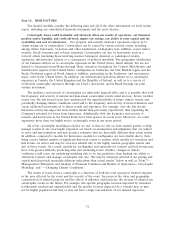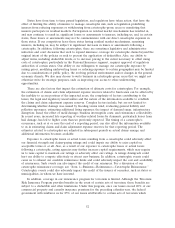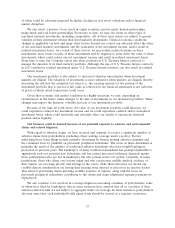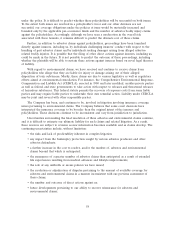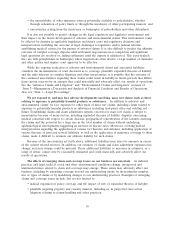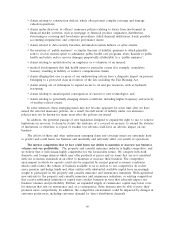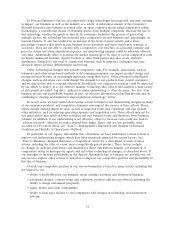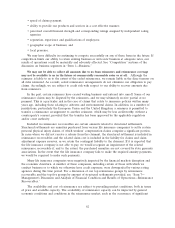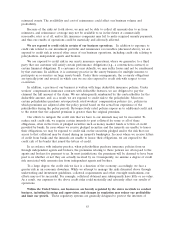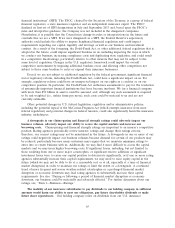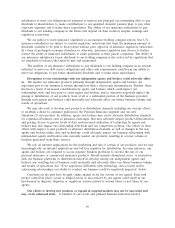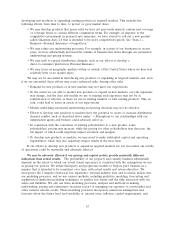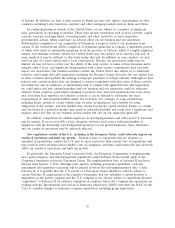Travelers 2013 Annual Report Download - page 71
Download and view the complete annual report
Please find page 71 of the 2013 Travelers annual report below. You can navigate through the pages in the report by either clicking on the pages listed below, or by using the keyword search tool below to find specific information within the annual report.In Personal Insurance, the use of comparative rating technologies has impacted, and may continue
to impact, our business as well as the industry as a whole. A substantial amount of the Company’s
Personal Insurance new business is written after an agent compares quotes using comparative rating
technologies, a cost-efficient means of obtaining quotes from multiple companies. Because the use of
this technology, whether by agents or directly by customers, facilitates the process of generating
multiple quotes, the technology has increased price comparison on new business and, increasingly, on
renewal business. It also has resulted in an increase in the level of quote activity and a lower
percentage of quotes that result in new business from customers, and these trends may continue or
accelerate. If we are not able to operate with a competitive cost structure or accurately estimate and
price for claims and claim adjustment expenses, our underwriting margins could be adversely affected
over time. Additionally, there is potential for similar technology to be used to access comparative rates
for small commercial business. Agents, brokers or other third parties may also create alternate
distribution channels for personal or commercial business, such as insurance exchanges, that may
adversely impact product differentiation and pricing.
Other technological changes may present competitive risks. For example, innovations, such as
telematics and other usage-based methods of determining premiums, can impact product design and
pricing and may become an increasingly important competitive factor. Other potential technological
changes, such as driverless cars, could disrupt the demand for our products from current customers,
and we may not be able to respond effectively. In addition, our competitive position could be impacted
by our ability to deploy, in a cost effective manner, technology that collects and analyzes a wide variety
of data points (so-called ‘‘big data’’ analysis) to make underwriting or other decisions. See also ‘‘Our
business success and profitability depend, in part, on effective information technology systems and on
continuing to develop and implement improvements in technology’’ below.
In recent years, we have undertaken various actions to improve our underwriting margins on many
of our insurance products, and competitive dynamics may impact the success of these efforts. These
efforts include seeking improved rates, as well as improved terms and conditions, and also include
other initiatives, such as reducing operating expenses and acquisition costs. These efforts may not be
successful and/or may result in lower retention and new business levels and therefore lower business
volumes. In addition, if our underwriting is not effective, efforts to increase rates could also lead to
‘‘adverse selection’’, whereby accounts retained have higher losses, and are less profitable, than
accounts lost. For more detail, see ‘‘Item 7—Management’s Discussion and Analysis of Financial
Condition and Results of Operations—Outlook.’’
In particular, in our Agency Automobile line of business, we have undertaken various actions to
improve our underwriting margins, which have been negatively impacted by various factors. See
‘‘Item 1—Business—Personal Insurance—Competition’’ above for a description of some of these
actions, including the offer of a new, more competitively-priced product. These factors include
(i) changes in customer preferences and demand for direct distribution channels, (ii) utilization of
comparative rating technologies by agents and (iii) other technological changes, as described above. If
our strategies to increase profitability in the Agency Automobile line of business are not effective, we
may need to explore other actions or initiatives to improve our competitive position and profitability in
this line of business.
Overall, our competitive position in our various businesses is based on many factors, including but
not limited to our:
• ability to profitably price our business, retain existing customers and obtain new business;
• premiums charged, contract terms and conditions, products and services offered (including the
ability to design customized programs);
• agent, broker and client relationships;
• ability to keep pace relative to our competitors with changes in technology and information
systems;
61


